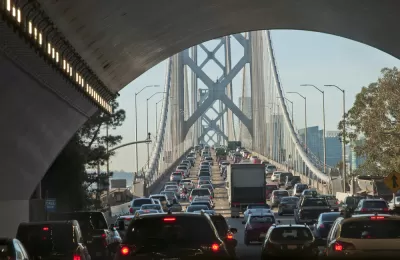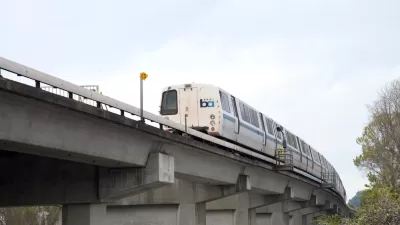In December, Sen. Dianne Feinstein reactivated her call for a southern crossing over the Bay while the BART Board last week began studying a second Transbay tube. The San Francisco Chronicle editorial board opines on which is preferable.

California's senior U.S. senator, Dianne Feinstein, and Rep. Mark DeSaulnier, (D-Concord) have asked the San Francisco Bay Area's transportation agency, the Metropolitan Transportation Commission, to consider a bridge option to provide relief for transbay travelers between the East Bay and West Bay, which includes San Francisco. Meanwhile, the Bay Area Rapid Transit (BART) District board began planning for a second transbay tube which could possibly include standard gauge tracks to carry commuter and intercity trains.
It boils down to a modal competition, as one would accommodate primarily motorists, and the other BART passengers and potentially passengers on other rail lines.
"One makes sense and the other should be tossed," opines the editorial board of the San Francisco Chronicle on Feb. 22.
BART is facing crush load capacity limits and its leaders are giving serious thought to a second Transbay Tube. It’s an enormous undertaking — likely the biggest infrastructure project ever in the region — but it could bring benefits in a variety of ways, not just a quicker commute ride.
Another, older idea is making a modest comeback, but that doesn’t mean it makes sense. A long-discussed “second crossing” that calls for another car-carrying bridge connecting the east and west sides of the bay ... But it’s the wrong answer, given scarce money and changing travel needs. [Feinstein's] request for a battle plan on building such a span should be respectfully shelved.
The dream of the "southern crossing" even predates Feinstein's term as mayor of San Francisco. "In 1972, the state of California placed a proposal to build the Southern Crossing before voters in San Francisco, Alameda, Contra Costa, Marin and San Mateo counties," reported Dennis Evanosky last June for the Oakland Conduit. "Voters said 'no' by more than a three-to-one margin."
The issue takes on some political importance as voters in all nine Bay Area counties go to the polls in a just over four months to vote on Regional Measure 3, a modest toll increase of $3 on all seven state-owned toll Bridges in the Bay Area over six years. The measure "would provide $50 million for planning and preliminary engineering of a second rail tube connecting the East Bay and San Francisco," according to the Metropolitan Transportation Commission. Feinstein and DeSaulnier want a bridge study included.
A rail tunnel(s) could also provide standard gauge rail tracks to accommodate Capitol Corridor, Caltrain, or Amtrak trains. Michael Cabanatuan describes that option in his piece (posted here) in the San Francisco Chronicle last week. BART trains operate on a wide gauge track used by few, if any, other rail systems.
What was omitted in the editorial was the effect of what a second transbay crossing would have on growth and land use. It's a classic case of choosing to invest in highways or public transit. The former promotes sprawl while the latter facilitates compact growth.
Related in Planetizen:
"Consensus is brewing that a new transbay rail line is needed to solve the problem. A big-picture vision for a second transbay BART tube (which SPUR called for in a 2009 Report), has gained traction in recent months. A second transbay rail tube — be it for BART, standard rail like Caltrain or Amtrak, high-speed rail or a combination of the three — is essential to solving the Bay Area’s transit capacity crunch."
FULL STORY: Editorial: To address Bay Area traffic, build the tube, skip the bridge

Manufactured Crisis: Losing the Nation’s Largest Source of Unsubsidized Affordable Housing
Manufactured housing communities have long been an affordable housing option for millions of people living in the U.S., but that affordability is disappearing rapidly. How did we get here?

Americans May Be Stuck — But Why?
Americans are moving a lot less than they once did, and that is a problem. While Yoni Applebaum, in his highly-publicized article Stuck, gets the reasons badly wrong, it's still important to ask: why are we moving so much less than before?

Using Old Oil and Gas Wells for Green Energy Storage
Penn State researchers have found that repurposing abandoned oil and gas wells for geothermal-assisted compressed-air energy storage can boost efficiency, reduce environmental risks, and support clean energy and job transitions.

California Governor Suspends CEQA Reviews for Utilities in Fire Areas
Utility restoration efforts in areas affected by the January wildfires in Los Angeles will be exempt from environmental regulations to speed up the rebuilding of essential infrastructure.

Native American Communities Prepare to Lead on Environmental Stewardship
In the face of federal threats to public lands and conservation efforts, indigenous groups continue to model nature-centered conservation efforts.

Proposed Bill Would Direct Funds to Road Safety
The Sarah Debbink Langenkamp Active Transportation Safety Act was spurred by the death of a U.S. diplomat who was killed on her bicycle.
Urban Design for Planners 1: Software Tools
This six-course series explores essential urban design concepts using open source software and equips planners with the tools they need to participate fully in the urban design process.
Planning for Universal Design
Learn the tools for implementing Universal Design in planning regulations.
Heyer Gruel & Associates PA
City of Moreno Valley
Institute for Housing and Urban Development Studies (IHS)
City of Grandview
Harvard GSD Executive Education
Salt Lake City
NYU Wagner Graduate School of Public Service
City of Cambridge, Maryland





























